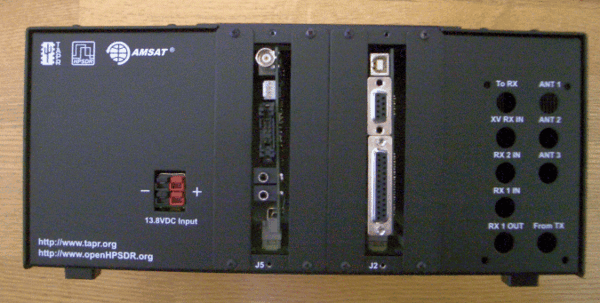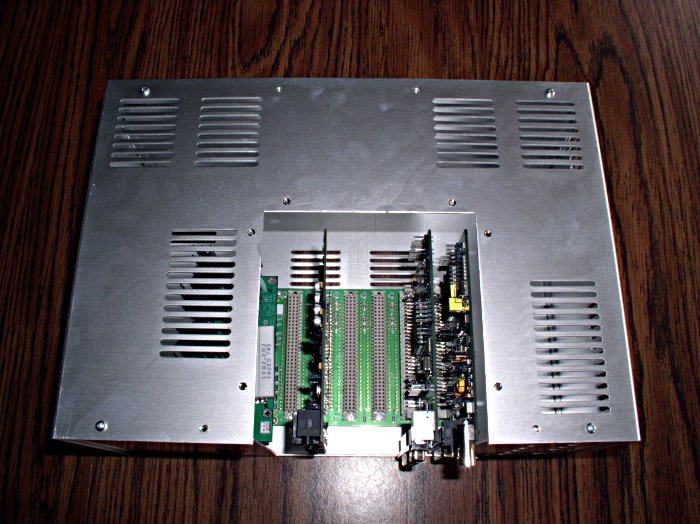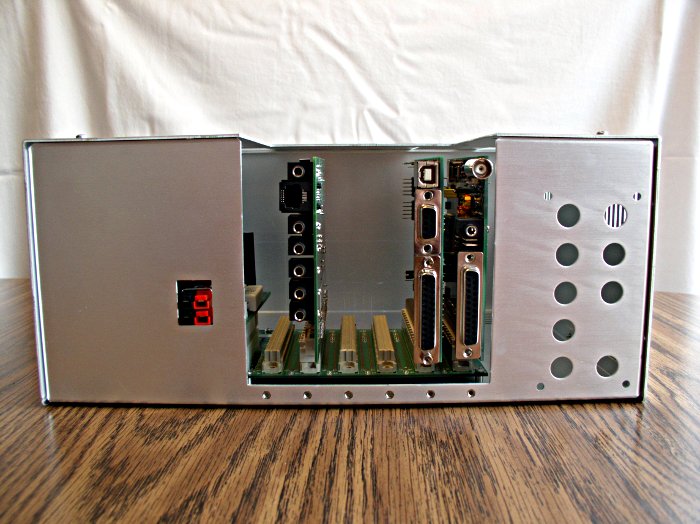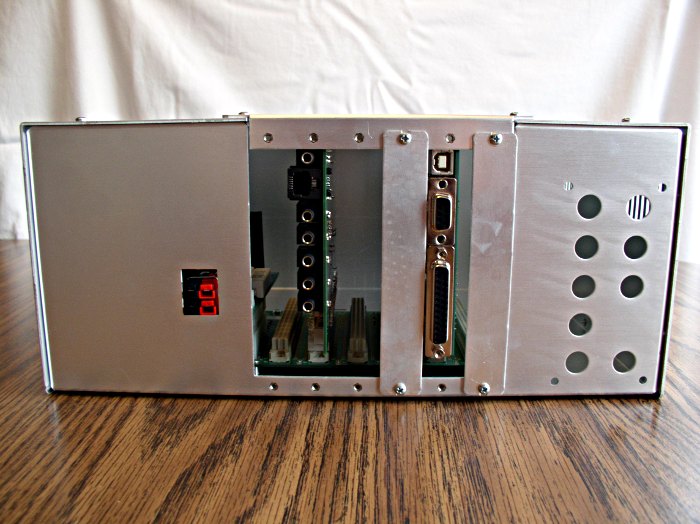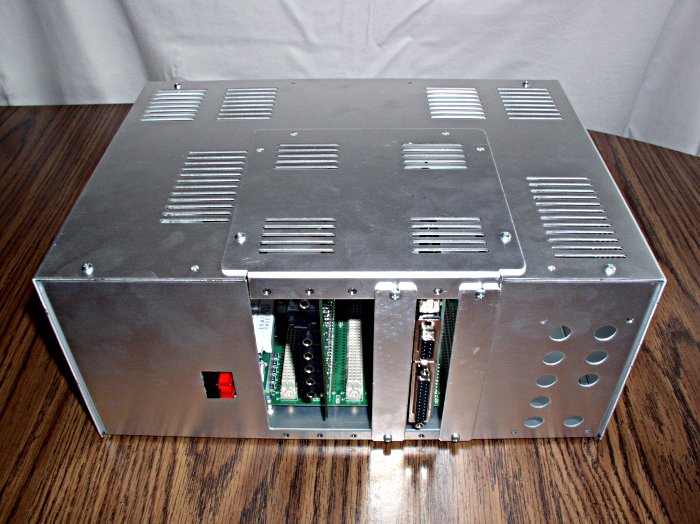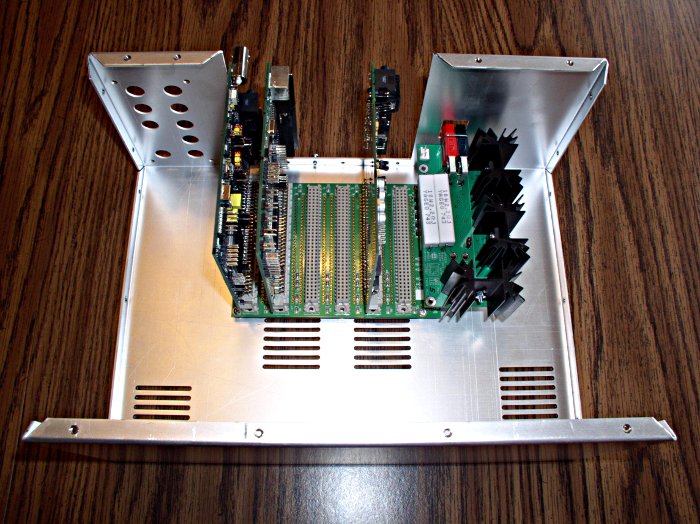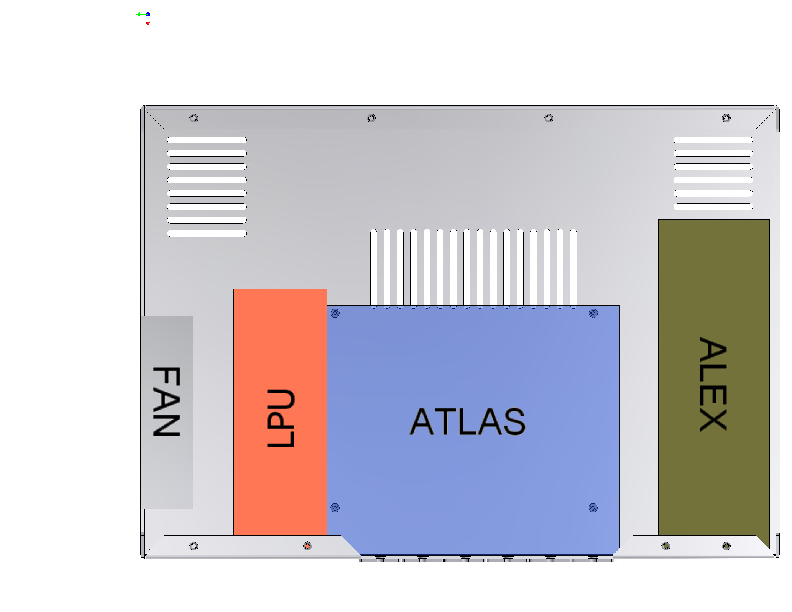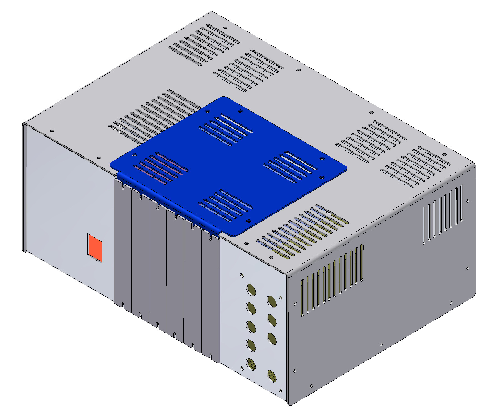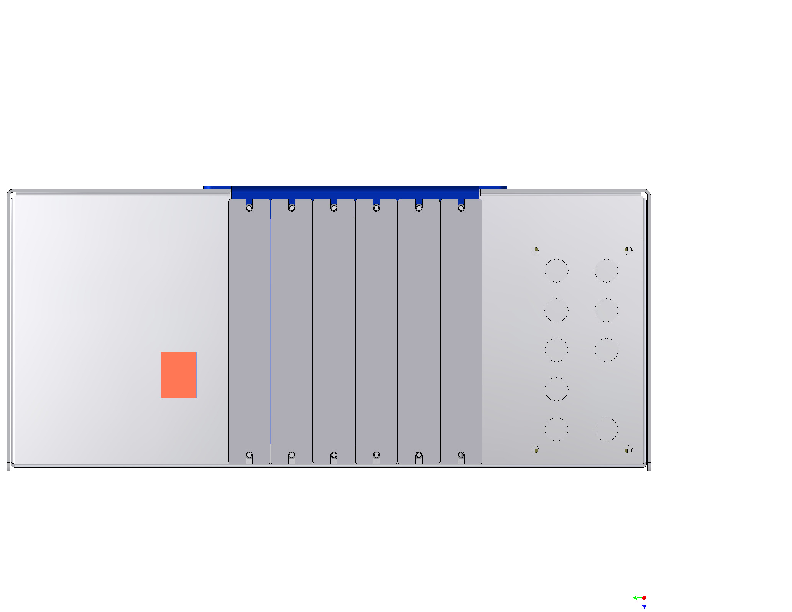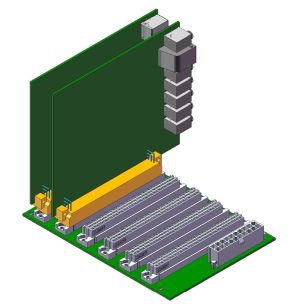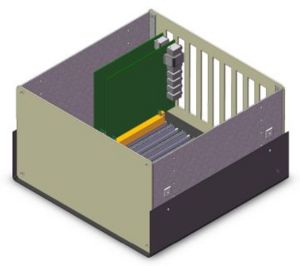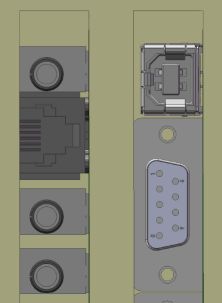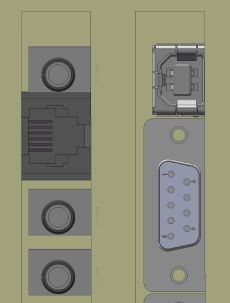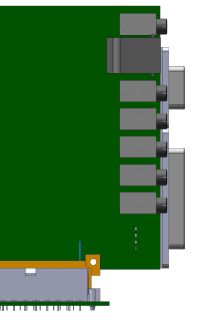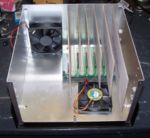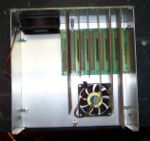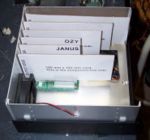Difference between revisions of "PANDORA"
(→PANDORA) |
(wiki, spelling) |
||
| (33 intermediate revisions by 5 users not shown) | |||
| Line 1: | Line 1: | ||
| + | [[Image:pandora.gif|thumb|600px|Pandora with [[MERCURY|Mercury]], [[OZY|Ozy]], and [[LPU]] installed. Mercury is at the left edge so the fan will circulate air across the LTC2208. The apparent bulging of the cabinet is optical distortion, not mechanical! de KK7P]] | ||
| + | |||
| + | == Pandora Mechanical Drawings == | ||
| + | |||
| + | Here are mechanical drawings showing the dimensions and hole placements for Pandora. | ||
| + | * [[Media:e-6409-HT,62409.pdf|Chassis before bending]] | ||
| + | * [[Media:e-6409,62409.pdf|Chassis after bending and with silkscreen]] | ||
| + | * [[Media:E-6410,42009.pdf|Top Panel]] | ||
| + | * [[Media:E-6412,42009.pdf|Access Plate]] | ||
| + | * [[Media:E-6411,42009.pdf|Card Plate]] | ||
| + | |||
| + | == PANDORA Mark II UPDATE (13 May 2009) == | ||
| + | Pandora is now finished and the production order has been placed with the manufacturer. The price will be $99 for TAPR members and $109 for non-members. Shipment will probably begin sometime in June. The TAPR web site is '''not''' ready to take orders yet; that will probably happen sometime after Hamvention. | ||
| + | |||
| + | We will have two HPSDR stations (hopefully talking to each other!) at the TAPR Dayton Hamvention booth this weekend. Both stations are mounted in Pandora prototypes, so stop by and take a look! | ||
| + | |||
| + | == PANDORA Mark II ENCLOSURE CONCEPT (Revised -- 11 March 2009)== | ||
| + | |||
| + | After we learned that Ben Hall had stepped aside from active work on the HPSDR "Pandora" enclosure, Phil Harman VK6APH, Scott Cowling WA2DFI, and John Ackermann N8UR sat down together at the ARRL/TAPR DCC in Chicago (September 2008) and roughed out a basic enclosure that we thought could be designed and gotten into production quickly. John [mailto:[email protected]] took the design lead. | ||
| + | |||
| + | Working with a major enclosure manufacturer, we're happy to report that the Pandora "Mark II" design is just about ready for production, and will be offered through TAPR. | ||
| + | |||
| + | Here are some details about the design, followed by some drawings to help you visualize it. | ||
| + | |||
| + | * Dimensions are (approximately) 12.2 inches wide, 8.7 inches deep, and 5.3 inches high (footprint such that an SDR-1000 can sit on top of it) | ||
| + | * Atlas mounts in the center rear with six covered slots for access to card I/O (like slots in a PC case) | ||
| + | * "Hatch" in top cover to allow card access without disassembling the case | ||
| + | * Room for LPU power supply | ||
| + | * Room for Alex filter bank, and rear panel cutouts for Alex connectors | ||
| + | * Numerous cooling vents, and provision for a fan | ||
| + | * About 3 x 12 inches of unused space across the front for additional component mounting (perhaps an amplifier???) | ||
| + | * Made of .062 aluminum for easy drilling; several spare holes already drilled for additional connections | ||
| + | * Nicely painted | ||
| + | |||
| + | Here are some photos of the first unpainted prototype; not all accessory holes are drilled, and there will be a few metalwork corrections, but this shows how the enclosure works: | ||
| + | * [[Image:pandora_proto_1_scaled.jpg]] | ||
| + | * [[Image:pandora_proto_2_scaled.jpg]] | ||
| + | * [[Image:pandora_proto_3_scaled.jpg]] | ||
| + | * [[Image:pandora_proto_4_scaled.jpg]] | ||
| + | * [[Image:pandora_proto_5_scaled.jpg]] | ||
| + | |||
| + | == Top view, looking down: == | ||
| + | * [[Image:Pandora_Top_inside.png]] | ||
| + | |||
| + | == Rear views: == | ||
| + | * [[Image:Pandora_Iso_Rear-Fan.png]] | ||
| + | * [[Image:Pandora_Iso_Rear-Vents.png]] | ||
| + | * [[Image:Pandora_Rear.png]] | ||
| + | |||
| + | == OLD PANDORA (MARK I) PAGE BELOW == | ||
| + | |||
== PANDORA ENCLOSURE CONCEPT == | == PANDORA ENCLOSURE CONCEPT == | ||
| Line 7: | Line 58: | ||
The Pandora name is taken from the old story of Pandora’s Box. One particular telling of the story states that Pandora’s Box was a holding vessel for all of the misfortunes of mankind. However, Pandora opened the box and all the misfortunes came out. However, Pandora was able to close the box quickly, and hope stayed inside. It is hoped that since Pandora has let all the evil out of the box with hope remaining inside, our Pandora’s box will have already had all of “smoke” let out, leaving only hope and goodness inside. | The Pandora name is taken from the old story of Pandora’s Box. One particular telling of the story states that Pandora’s Box was a holding vessel for all of the misfortunes of mankind. However, Pandora opened the box and all the misfortunes came out. However, Pandora was able to close the box quickly, and hope stayed inside. It is hoped that since Pandora has let all the evil out of the box with hope remaining inside, our Pandora’s box will have already had all of “smoke” let out, leaving only hope and goodness inside. | ||
| − | + | The Pandora Enclosure is actually not just a box, but a collection of "building block" like parts that can be utilized in the construction of an enclosure for an HPSDR. Early on, it was determined that each HPSDR user had unique requirements for the enclosure of their HPSDR. With a "building block" concept, each HPSDR user can chose only the parts they will use from the collection: | |
| − | + | ||
| − | The Pandora Enclosure is actually not just a box, but a collection of "building block" like parts that can be utilized in the construction of an enclosure for an HPSDR. Early on, it was determined that each HPSDR user had unique requirements for the enclosure of | + | |
=== An End Panel === | === An End Panel === | ||
| Line 44: | Line 93: | ||
9) Of course, it should look nice! | 9) Of course, it should look nice! | ||
| + | |||
| + | == FUTURE CHALLENGES == | ||
| + | |||
| + | As Pandora is hitting a moving target, any information on what folks are thinking in the following areas would help: | ||
| + | |||
| + | 1) Power consumption / Heat dissipation. So far, with Ozy/Janus, this appears to not be a big deal. | ||
| + | |||
| + | 2) Card size. Right now, Ozy/Janus are on the smaller end of the possible sizes for cards. If future cards are going to trend closer to the 220 mm maximum, this would be good to know now. | ||
| + | |||
| + | 3) Power supplies. If a pico ITX power supply is used (see www.mini-box.com), very little dedicated space is needed for a power supply. If something larger will be the norm, the enclosure size may have to grow. | ||
== CURRENT STATUS == | == CURRENT STATUS == | ||
| − | Update | + | ==='''Update, 3 Sept 2007.'''=== |
| − | + | Due to work and family commitments, progress on Pandora has slowed down a bit. Thankfully, I got a good block of time today to do some work on the BK-959 Pandora Enclosure. I'm specifically referring to it as the "BK-959" enclosure to prevent confusion with the second concept I referred to in the 26 May 2007 update. | |
| + | |||
| + | The first thing I completed today was a solid model of the Atlas with an Ozy and Janus installed: | ||
| + | |||
| + | [[Image:AtlasJanusOzyModel.jpg|300x400px|A solid model of Atlas with Ozy and Janus installed.]] | ||
| + | |||
| + | I then started fitting it into the model of the BK-959 case with a tentative slot layout: | ||
| + | |||
| + | [[Image:BK959wAtlasOzyJanus.jpg|300x400px|A solid model of the Ten-Tec BK-959 case with Atlas, Ozy, and Janus installed.]] | ||
| + | |||
| + | As I moved around the Atlas/Janus/Ozy assembly to align the boards with the slots, I noticed a problem. If I centered the DB9 and DB25 connectors on Ozy in the center of the slots, the audio jacks and RJ45 jacks on Janus were off-center. Off-center enough that I think one would have trouble inserting the RJ45 plug into the jack: | ||
| + | |||
| + | [[Image:Dbscentered.jpg|300x400px|DB connectors centered in the slot.]] | ||
| + | |||
| + | Now, if I center the audio jacks on Janus so they are centered and that inserting the RJ45 plug would be easy, the DB connectors are now off-center and I imagine one would have a hard time inserting a USB cable into the USB connector on Ozy: | ||
| + | |||
| + | [[Image:Audioscentered.jpg|300x400px|Audio connectors centered in the slot.]] | ||
| + | |||
| + | Okay, that's something I think I can solve by opening up the width of the slots and with the design of the close-out strips. | ||
| + | |||
| + | '''A question for those of you who have installed an Atlas/Janus/Ozy assembly into a PC case - how did you solve this? I'd really like to hear your ideas, either on the reflector, or to my e-mail address. Did you open the slot widths up?''' | ||
| + | |||
| + | Knowing that I probably could fix the centering issue with wider slots, I started to position the Atlas/Janus/Ozy assembly in the fore/aft direction of the case. I then noticed that Ozy and Janus have differing amounts of connector protrusion: | ||
| + | |||
| + | [[Image:Sideview.jpg|300x400px|Side view of the Atlas/Janus/Ozy assembly showing the different connector protrusions.]] | ||
| + | |||
| + | Obviously, the Ozy board has connectors that protrude the farthest, so they will set the position of the Atlas/Janus/Ozy assembly within the case relative to the plane of the slots on the rear of the case. This will result in the Janus connectors being ever-so-slightly recessed inside the case. It will have to be seen in an actual prototype if this presents any issues. | ||
Ben, KD5BYB. | Ben, KD5BYB. | ||
| + | |||
| + | ==='''Update, 26 May 2007.'''=== | ||
| + | |||
| + | Progress continues on Pandora. From what I've heard from the folks that manned the HPSDR booth at Dayton Hamvention, a common question was "Got an enclosure?" After some discussion on the reflector, it was decided that Pandora needed to move from the "analysis of alternatives" stage to focusing on a design based on the Ten-Tec BK-959 case. For sure, the Ten-Tec BK-959 isn't perfect. But, it's a good quality case, especially considering that the price for one off the shelf at Ten-Tec is about $50. | ||
| + | |||
| + | The next thing on the "to-do" list for Pandora is to create solid models of the components and the case. This is in progress. Below is a picture of Janus model that is still in the works: | ||
| + | |||
| + | [[Image:Janus model.jpg|300x400px|A solid model of the Janus board, not yet complete.]] | ||
| + | |||
| + | A fellow HPSDR enthusiast who for now wishes to remain anonymous has stepped forward to help generate solid models of the existing HPSDR component boards, so this task should be far shorter than if I were doing it alone. | ||
| + | |||
| + | Ben, KD5BYB. | ||
| + | |||
| + | ==='''Update, 23 April 2007.'''=== | ||
| + | |||
| + | It's been awhile since an entry has been made here, but progress has not stopped! Have had discussions with Ten-Tec regarding BK-959 shielding - as pointed out on the reflector, Ten-Tec confirms that the BK-959 as-is doesn't ground the top and bottom case halves (clamshells) to the inner pieces of the case. They presented a simple modification that would allow this to take place. This modification design as well as another are being evaluated now. Have had lengthy discussions with Buckeye Shapeform regarding their line of cases - so far, they are above the $50 US price target by a factor of two. Have also checked out Lansing enclosures, they too exceed the price target by a factor of two. | ||
| + | |||
| + | The case search will continue, but it appears that even with the problem noted above, the BK-959 case is a viable option. For photo/discussion purposes, a physical model was constructed: | ||
| + | |||
| + | [[Image:Top-Angle.jpg|150x250px|Angled view of BK-959 with Atlas and cards from Ozy/Janus size to 220mm maximum length.]] | ||
| + | [[Image:Top-front.jpg|150x250px|Top front view of BK-959 with Atlas and cards.]] | ||
| + | [[Image:Top.jpg|150x250px|Top view of BK-959 with Atlas and cards.]] | ||
| + | [[Image:Side.jpg|150x250px|Side view of BK-959 with Atlas and cards.]] | ||
| + | |||
| + | Discussion of the Photos Above: | ||
| + | |||
| + | The Atlas card is mounted up about 0.4" (10.5mm or so) from the chassis by small screws. Atlas is located such that the input/output connector edges of the cards are flush with the rear panel. It may be preferable to have the input/output connector edges protrude slightly through the rear panel (see End Panel discussion above). | ||
| + | |||
| + | (Note: what is called the front/rear panels here may be reversed in your application, depending if you want the card input/output connectors at the front or rear. This is simply a handy nomenclature for this discussion.) | ||
| + | |||
| + | Two fans are included to give some idea of scale. The fan in the rear of the first three photos is a standard 80mm square computer power-supply fan. The fan laying flat is a slightly smaller, 70mm square fan that is only 15.5mm thick. The fan laying flat shows that there is space under the cards for a fan(s) or card-to-card cabling. The cards installed from left to right are 185mm, Janus, Ozy, 160mm, 185mm, and 220mm. | ||
| + | |||
| + | As can be seen, if the Atlas card is fully populated with 220mm length cards like the one on the far right in the first three photos, there is no room for any sort of controls on the front panel. Yet, if the maximum card length is restricted to 185mm, one has about 1.5" (38.76mm) of front panel control space. For shorter cards, space increases of course. | ||
| + | |||
| + | Ben, KD5BYB. | ||
| + | |||
| + | ==='''Update, 2 April 2007.'''=== | ||
| + | |||
| + | Have contacted Ten-Tec and confirmed that they do not have non-USA distribution on their fine line of enclosures. Have contacted Buckeye Shapeform and am evaluating their line of cases as another potential source for Pandora; will ask them about non-USA distribution. Received input from several non-USA HPSDR enthusiasts, am exploring cases sold by HiFi in Italy ([http://www.hifi2000.it HiFi2000]) and by Vero and by Schroff (links forthcoming). Any other sources of cases from abroad or from here in the USA are welcome at the e-mail link above! Still working End Panel design, have rough preliminary concept laid out that slots the entire End Panel. Status entry below updated to reflect year 2007 instead of 2006. | ||
| + | |||
| + | Ben, KD5BYB. | ||
| + | |||
| + | ==='''Update, 25 March 2007.'''=== | ||
| + | |||
| + | Initial entry to HPSDRwiki. Ordered and received prototype of Ten-Tec BK-959 case. Received PDF and AutoCAD drawings of BK-959 from Ten-Tec. Have drawn up and fabricated cardboard mock-ups of the possible sizes of HPSDR cards ranging from 100 mm by 120 mm all the way to the maximum size of 100 mm by 220 mm. Currently working on End Panel design, have expanded design from 6 slots (which matched Atlas exactly) to as many slots as the End Panel will allow. This allows users to use the "extra" slots for expansion. Have inquired with Ten-Tec as to non-USA distribution possibilities. Working on contacting Buckeye Shapeform as another source of enclosures. | ||
| + | |||
| + | Ben, KD5BYB. | ||
| + | |||
| + | [[Category:Hardware available]] | ||
Latest revision as of 12:06, 25 January 2010
Contents
- 1 Pandora Mechanical Drawings
- 2 PANDORA Mark II UPDATE (13 May 2009)
- 3 PANDORA Mark II ENCLOSURE CONCEPT (Revised -- 11 March 2009)
- 4 Top view, looking down:
- 5 Rear views:
- 6 OLD PANDORA (MARK I) PAGE BELOW
- 7 PANDORA ENCLOSURE CONCEPT
- 8 BACKGROUND
- 9 DESIGN GUIDELINES
- 10 FUTURE CHALLENGES
- 11 CURRENT STATUS
Pandora Mechanical Drawings
Here are mechanical drawings showing the dimensions and hole placements for Pandora.
PANDORA Mark II UPDATE (13 May 2009)
Pandora is now finished and the production order has been placed with the manufacturer. The price will be $99 for TAPR members and $109 for non-members. Shipment will probably begin sometime in June. The TAPR web site is not ready to take orders yet; that will probably happen sometime after Hamvention.
We will have two HPSDR stations (hopefully talking to each other!) at the TAPR Dayton Hamvention booth this weekend. Both stations are mounted in Pandora prototypes, so stop by and take a look!
PANDORA Mark II ENCLOSURE CONCEPT (Revised -- 11 March 2009)
After we learned that Ben Hall had stepped aside from active work on the HPSDR "Pandora" enclosure, Phil Harman VK6APH, Scott Cowling WA2DFI, and John Ackermann N8UR sat down together at the ARRL/TAPR DCC in Chicago (September 2008) and roughed out a basic enclosure that we thought could be designed and gotten into production quickly. John [1] took the design lead.
Working with a major enclosure manufacturer, we're happy to report that the Pandora "Mark II" design is just about ready for production, and will be offered through TAPR.
Here are some details about the design, followed by some drawings to help you visualize it.
- Dimensions are (approximately) 12.2 inches wide, 8.7 inches deep, and 5.3 inches high (footprint such that an SDR-1000 can sit on top of it)
- Atlas mounts in the center rear with six covered slots for access to card I/O (like slots in a PC case)
- "Hatch" in top cover to allow card access without disassembling the case
- Room for LPU power supply
- Room for Alex filter bank, and rear panel cutouts for Alex connectors
- Numerous cooling vents, and provision for a fan
- About 3 x 12 inches of unused space across the front for additional component mounting (perhaps an amplifier???)
- Made of .062 aluminum for easy drilling; several spare holes already drilled for additional connections
- Nicely painted
Here are some photos of the first unpainted prototype; not all accessory holes are drilled, and there will be a few metalwork corrections, but this shows how the enclosure works:
Top view, looking down:
Rear views:
OLD PANDORA (MARK I) PAGE BELOW
PANDORA ENCLOSURE CONCEPT
The project leader for the Pandora Enclosure is Ben Hall [2], KD5BYB.
BACKGROUND
The Pandora name is taken from the old story of Pandora’s Box. One particular telling of the story states that Pandora’s Box was a holding vessel for all of the misfortunes of mankind. However, Pandora opened the box and all the misfortunes came out. However, Pandora was able to close the box quickly, and hope stayed inside. It is hoped that since Pandora has let all the evil out of the box with hope remaining inside, our Pandora’s box will have already had all of “smoke” let out, leaving only hope and goodness inside.
The Pandora Enclosure is actually not just a box, but a collection of "building block" like parts that can be utilized in the construction of an enclosure for an HPSDR. Early on, it was determined that each HPSDR user had unique requirements for the enclosure of their HPSDR. With a "building block" concept, each HPSDR user can chose only the parts they will use from the collection:
An End Panel
This will be an end panel with slots punched out in a fashion similar to what is on the rear of a desktop computer. It will mate to a Commercial Off-The-Shelf (COTS) enclosure. It will also have provisions to allow Close-Out Strips to be attached as well as having provisions to mount the End Panel to a Bottom Plate.
Close-Out Strips
These strips will be of several designs. They will act like the metal brackets on the back of a standard desktop computer card - they'll fit the punched out slot in the End Panel and will have openings that match each HPSDR card. Some strips will be "blank," allowing closing out of unused slots.
A Bottom Plate
The bottom plate will have provisions to accept an Atlas card and provide provisions for mounting the bottom plate to the End Panel, allowing alignment of cards plugged into Atlas with the slots in the End Panel.
DESIGN GUIDELINES
The Pandora design is going to be an attempt to hit a moving target. There are cards currently undergoing design and test as this is being written. Therefore, unfortunately, the Pandora design will somewhat constrain card design. Its hoped that these constraints won’t be too much:
1) Atlas will be the “backplane” card for Pandora.
2) Pandora will accept cards no larger than 100 by 220 mm.
3) Pandora won’t be able to house an amplifier or other card with significant heat dissipation. (Discussions already point to a future power amplifier requiring a power supply in excess of what Atlas can support.)
4) Pandora will try to be as friendly as possible for non-USA HPSDR users. Ideally, this will include selection of a commercial enclosure available outside the USA. If not, the parts will be made as flat as possible for the lowest cost in mailing.
5) Pandora will try and minimize the amount of custom-made parts and focus on what can be obtained off the shelf.
6) Pandora will allow for easy access to the cards contained within with minimal disassembly. It is expected some users will use Pandora to house future HPSDR prototype cards.
7) Pandora will follow the standard HPSDR procedures. It won’t be designed in a vacuum and user input will be sought.
8) Materials chosen will allow for the best possible mix of shielding and easy of modification. Ideally, the outer case will be steel for durability and shielding with the remainder of the parts being aluminum for ease of modification.
9) Of course, it should look nice!
FUTURE CHALLENGES
As Pandora is hitting a moving target, any information on what folks are thinking in the following areas would help:
1) Power consumption / Heat dissipation. So far, with Ozy/Janus, this appears to not be a big deal.
2) Card size. Right now, Ozy/Janus are on the smaller end of the possible sizes for cards. If future cards are going to trend closer to the 220 mm maximum, this would be good to know now.
3) Power supplies. If a pico ITX power supply is used (see www.mini-box.com), very little dedicated space is needed for a power supply. If something larger will be the norm, the enclosure size may have to grow.
CURRENT STATUS
Update, 3 Sept 2007.
Due to work and family commitments, progress on Pandora has slowed down a bit. Thankfully, I got a good block of time today to do some work on the BK-959 Pandora Enclosure. I'm specifically referring to it as the "BK-959" enclosure to prevent confusion with the second concept I referred to in the 26 May 2007 update.
The first thing I completed today was a solid model of the Atlas with an Ozy and Janus installed:
I then started fitting it into the model of the BK-959 case with a tentative slot layout:
As I moved around the Atlas/Janus/Ozy assembly to align the boards with the slots, I noticed a problem. If I centered the DB9 and DB25 connectors on Ozy in the center of the slots, the audio jacks and RJ45 jacks on Janus were off-center. Off-center enough that I think one would have trouble inserting the RJ45 plug into the jack:
Now, if I center the audio jacks on Janus so they are centered and that inserting the RJ45 plug would be easy, the DB connectors are now off-center and I imagine one would have a hard time inserting a USB cable into the USB connector on Ozy:
Okay, that's something I think I can solve by opening up the width of the slots and with the design of the close-out strips.
A question for those of you who have installed an Atlas/Janus/Ozy assembly into a PC case - how did you solve this? I'd really like to hear your ideas, either on the reflector, or to my e-mail address. Did you open the slot widths up?
Knowing that I probably could fix the centering issue with wider slots, I started to position the Atlas/Janus/Ozy assembly in the fore/aft direction of the case. I then noticed that Ozy and Janus have differing amounts of connector protrusion:
Obviously, the Ozy board has connectors that protrude the farthest, so they will set the position of the Atlas/Janus/Ozy assembly within the case relative to the plane of the slots on the rear of the case. This will result in the Janus connectors being ever-so-slightly recessed inside the case. It will have to be seen in an actual prototype if this presents any issues.
Ben, KD5BYB.
Update, 26 May 2007.
Progress continues on Pandora. From what I've heard from the folks that manned the HPSDR booth at Dayton Hamvention, a common question was "Got an enclosure?" After some discussion on the reflector, it was decided that Pandora needed to move from the "analysis of alternatives" stage to focusing on a design based on the Ten-Tec BK-959 case. For sure, the Ten-Tec BK-959 isn't perfect. But, it's a good quality case, especially considering that the price for one off the shelf at Ten-Tec is about $50.
The next thing on the "to-do" list for Pandora is to create solid models of the components and the case. This is in progress. Below is a picture of Janus model that is still in the works:
A fellow HPSDR enthusiast who for now wishes to remain anonymous has stepped forward to help generate solid models of the existing HPSDR component boards, so this task should be far shorter than if I were doing it alone.
Ben, KD5BYB.
Update, 23 April 2007.
It's been awhile since an entry has been made here, but progress has not stopped! Have had discussions with Ten-Tec regarding BK-959 shielding - as pointed out on the reflector, Ten-Tec confirms that the BK-959 as-is doesn't ground the top and bottom case halves (clamshells) to the inner pieces of the case. They presented a simple modification that would allow this to take place. This modification design as well as another are being evaluated now. Have had lengthy discussions with Buckeye Shapeform regarding their line of cases - so far, they are above the $50 US price target by a factor of two. Have also checked out Lansing enclosures, they too exceed the price target by a factor of two.
The case search will continue, but it appears that even with the problem noted above, the BK-959 case is a viable option. For photo/discussion purposes, a physical model was constructed:
Discussion of the Photos Above:
The Atlas card is mounted up about 0.4" (10.5mm or so) from the chassis by small screws. Atlas is located such that the input/output connector edges of the cards are flush with the rear panel. It may be preferable to have the input/output connector edges protrude slightly through the rear panel (see End Panel discussion above).
(Note: what is called the front/rear panels here may be reversed in your application, depending if you want the card input/output connectors at the front or rear. This is simply a handy nomenclature for this discussion.)
Two fans are included to give some idea of scale. The fan in the rear of the first three photos is a standard 80mm square computer power-supply fan. The fan laying flat is a slightly smaller, 70mm square fan that is only 15.5mm thick. The fan laying flat shows that there is space under the cards for a fan(s) or card-to-card cabling. The cards installed from left to right are 185mm, Janus, Ozy, 160mm, 185mm, and 220mm.
As can be seen, if the Atlas card is fully populated with 220mm length cards like the one on the far right in the first three photos, there is no room for any sort of controls on the front panel. Yet, if the maximum card length is restricted to 185mm, one has about 1.5" (38.76mm) of front panel control space. For shorter cards, space increases of course.
Ben, KD5BYB.
Update, 2 April 2007.
Have contacted Ten-Tec and confirmed that they do not have non-USA distribution on their fine line of enclosures. Have contacted Buckeye Shapeform and am evaluating their line of cases as another potential source for Pandora; will ask them about non-USA distribution. Received input from several non-USA HPSDR enthusiasts, am exploring cases sold by HiFi in Italy (HiFi2000) and by Vero and by Schroff (links forthcoming). Any other sources of cases from abroad or from here in the USA are welcome at the e-mail link above! Still working End Panel design, have rough preliminary concept laid out that slots the entire End Panel. Status entry below updated to reflect year 2007 instead of 2006.
Ben, KD5BYB.
Update, 25 March 2007.
Initial entry to HPSDRwiki. Ordered and received prototype of Ten-Tec BK-959 case. Received PDF and AutoCAD drawings of BK-959 from Ten-Tec. Have drawn up and fabricated cardboard mock-ups of the possible sizes of HPSDR cards ranging from 100 mm by 120 mm all the way to the maximum size of 100 mm by 220 mm. Currently working on End Panel design, have expanded design from 6 slots (which matched Atlas exactly) to as many slots as the End Panel will allow. This allows users to use the "extra" slots for expansion. Have inquired with Ten-Tec as to non-USA distribution possibilities. Working on contacting Buckeye Shapeform as another source of enclosures.
Ben, KD5BYB.
